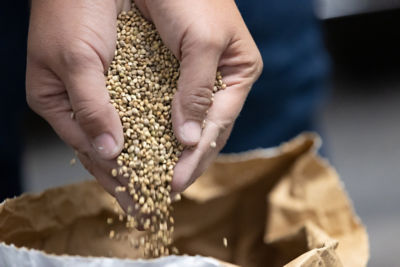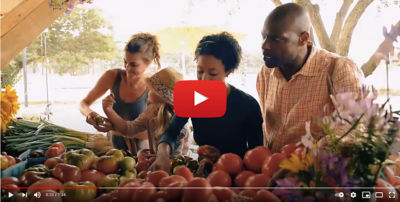Click here to download a PDF version of this spotlight.
» Blossom end rot of tomato is caused by a localized calcium deficiency within tomato fruit and/or environmental stress factors.
» Blossom end rot is often associated with fluctuations in soil moisture or rapid growth and rarely results from inadequate levels of calcium in the soil.
» Maintaining uniform soil moisture and preventing excessive vegetative growth can help minimize blossom end rot on tomato.
Blossom end rot (BER) of tomato is not an infectious disease caused by a pathogen but rather a physiological condition resulting from environmental conditions. BER often occurs following periods of fluctuating soil moisture, such as when heavy rains are followed by a dry period, followed by irrigation. The condition is most common with rapidly growing plants on early set fruit.1,2 The presence of BER on tomatoes renders that fruit unmarketable and can result substantial yield losses.3,4
SYMPTOMS
Symptoms of BER most commonly occur on the first tomatoes of the season but can appear at any time tomatoes are developing.5,6 Symptoms first appear as small, water-soaked, light-green, yellow, or brown spots at the blossom end of the fruit. However, by the time symptoms are noticed, the amount of damage is often much more extensive (Figure 1).2,7 The spots enlarge as the fruits grow, and they may eventually cover one-third to one-half of the fruit surface. The affected tissue becomes sunken, dark (brown to black), and leathery.2,8 Occasionally, internal fruit tissues can discolor and collapse with no external symptoms present.3
BER symptoms can be mistaken for other diseases and disorders such as sunscald and buckeye rot.6,7 Sunscald symptoms usually occur on the upper portion of the fruit, near the stem end. Tissues affected by BER are frequently colonized by secondary fungal and bacterial pathogens that further rot the fruit. Fungal growth on the senescent tissue can give the affected areas a black fuzzy appearance (Figure 2).1,2 Fruit with BER often ripen more quickly. Varieties vary in susceptibility to BER. Determinant varieties with abundant foliage and simultaneous fruit set and varieties with plum-shaped fruit are often more susceptible. Cherry tomatoes are usually not affected.4,8
 Figure 1. (A) Initial blossom end rot symptoms; (B) advanced symptoms. Dan Egel, Purdue University.
Figure 1. (A) Initial blossom end rot symptoms; (B) advanced symptoms. Dan Egel, Purdue University.
 Figure 2. Secondary mold growth on blossom end rot lesions. David Langston, University of Georgia, Bugwood.org.
Figure 2. Secondary mold growth on blossom end rot lesions. David Langston, University of Georgia, Bugwood.org.
CALCIUM AND BLOSSOM END ROOT
Many studies on BER support the theory that the problem results from a localized calcium deficiency in the fruit. Calcium serves several functions in the plant. Calcium is a component of calcium pectate, the material in cell walls that cements cells together. Calcium is needed by cells for normal cell growth, membrane stability, and for nutrient uptake. When plants are deficient in calcium growing tissues, cells start leaking, the tissue starts to break down, and the cells die.6,7
Plants absorb calcium in the soil solution through their roots. Calcium moves with water into the xylem and is carried up into the plant through the processes of transpiration and root pressure. Leaves are the primary drivers of transpiration, so most of the water, and thus calcium, move from the roots up into the leaves. Young leaves have the greatest density of stomata and a thin waxy cuticle layer, while fruits have fewer stomata and a thicker waxy cuticle. This is why water transpires more rapidly from leaves than it does from fruit and why more calcium is transported to the leaves.1,8
Root pressure is the primary method for moving water through the plant at night, and water movement through root pressure requires adequate amounts of soil moisture. Conditions that reduce water movement in the plant, such as low soil moisture, the closing of stomata, and cool, cloudy days, also reduce the movement of calcium within the plant.1,2,4
Developing fruit require a continuous calcium supply to prevent BER. Problems arise when the need for calcium in the fruit is greater than the amount that can be supplied by the plant. Increased transpiration from the leaves or decreased water movement can reduce the transport of calcium to the fruit. Calcium deficiencies in the fruit are most often a result of the calcium movement in the plant rather than a deficiency of calcium in the soil. There can be an abundance of calcium in the soil and other plant parts when BER occurs.1,5,8
There is some evidence that the lack of calcium is a result, not a cause of BER.9 This reseach indicates that BER is caused by other kinds of plant stress. More research is needed to verify the cause or causes of BER.10
FACTORS AFFECTING BLOSSOM END ROT
The two main factors that affect BER are soil moisture and the vegetative growth rate of the plant. Fluctuating soil moisture levels affect the rate and amount of calcium reaching the fruit, and improper water management can increase BER levels. Conditions that promote vegetative growth, such as nitrogen fertilization, can also result in increased BER.
Other factors can also contribute to BER. High levels of nutrients (cations), including phosphorus (P), magnesium (Mg), potassium (K), sodium (Na), and ammonium nitrogen (NH4 ) can reduce the concentrations of calcium (Ca) taken up by the roots.1,7,8 Loss of active root tissue from mechanical root pruning, root diseases, or flooding also reduces absorption of calcium. Weather factors, such as temperature and humidity, affect plant growth rate and transpiration, thus affecting the transportation of calcium within the plant.2,4 Tomato fruit in the rapid expansion phase (one to three weeks after pollination) are particularly susceptible to BER as they have the greatest need for adequate levels of calcium.At that time, the leaf to fruit surface area ratio is the greatest, and calcium is transported primarily to the leaves.4,5,8 However, BER can occur on expanding fruit at any time during fruit production.
BER rarely results from inadequate levels of calcium in the soil solution. Most agricultural soils have adequate calcium levels and receive regular fertilizers containing calcium. Soils containing high levels of calcium carbonate (limestone) naturally have adequate levels of available calcium, and well water used for irrigation is often a source of calcium.1,4
MANAGING BLOSSOM END ROT
BER is best managed by minimizing the conditions that favor the development of the problem. Proper soil moisture management is usually the most effective method for preventing BER. Irrigate plants to avoid moisture stress and minimize soil moisture fluctuations. Provide uniform moisture both during the day and at night. Irrigation timing and amounts should be adjusted based on rainfall to avoid over-watering. The use of plastic or organic mulches can help maintain uniform soil moisture levels by reducing evaporation from the soil. Some plastic mulches can warm the soil in the spring, increasing root activity. Silver or white-on-black mulches can help moderate temperatures in the summer and fall, lowering plant stress.1,5,8
Prevent excessive vegetative growth through balanced fertility. Ammonium (NH4 ) forms of nitrogen compete with calcium for root uptake, so applying nitrate (NO3 ) forms of nitrogen are less likely to increase levels of BER. Avoid side-dress applications during the onset of fruit set and development.6,7 Plant into a well-prepared soil bed and eliminate compaction zones that inhibit root growth. Minimize factors that damage roots or inhibit root activity, such as diseases, flooding, and mechanical root damage from tillage.2,4,5
Growers should use soil and water testing to determine calcium levels in their soils and irrigation water. Only apply calcium fertilizers to address problems with BER if soil testing indicates a calcium deficiency. Soil test values of medium (801 to 1,200 lb Ca/acre) or high (>1.200 lb Ca/acre) indicate that sufficient amounts of calcium are present in the soil.6 In soils with pH levels below 6.5 and high magnesium concentrations, applying lime to the soil can help increase the level of plantavailable calcium.1,8 Foliar applications of calcium also do not consistently reduce BER. Calcium is not absorbed well through the leaves, and it does not move from the leaves into the fruit because water does not flow that way in the plant, and calcium moves with water.1,6,7,8 When possible, plant tomato varieties that are less susceptible to blossom end rot.2,7
SOURCES
1 Hochmuth, G. and Hochmuth, R. 2015. Blossom-end rot in bell pepper: causes and prevention. UF IFAS Extension. Publication # SL 284.
2 Scott, J. 2014. Blossom-end rot. In Jones, J., Zitter, T., Momol, T., and Miller, S. (Eds.). Compendium of Tomato Diseases and Pests, Second Edition (p. 129). American Phytopathological Society. St. Paul.
3 Hansen, M.A. 2000. Blossom end rot of tomato. Publication 450-703W. Virginia Cooperative Extension Plant Disease Factsheets, Virginia Polytechnic Institute and State University, Blacksburg, VA.
4 Taylor, M.D. and S.J. Locascio. 2004. Blossom-end rot: A calcium deficiency. J. Plant Nutr. 27(1):123-139.
5 Michigan State University Extension. 2016. Blossom-end rot of tomato tip sheet.
6 Mayfield, J., William, T., and Westerfield, R. 2015. Blossom-end rot and calcium nutrition of pepper and tomato. UGA Extension. Circular 938.
7 Draper, M., Burrows, R., Munk, K. 2002. Blossom end rot of tomatoes and other vegetables. South Dakota Extension Fact Sheet 909.
8 Fake, C. 2010. Managing blossom-end rot in tomatoes and peppers. University of California Cooperative Extension. Publication Number 31-040C.
9 Saure, M. 2014. Why calcium deficiency is not the cause of blossomend rot in tomato and pepper fruit a reappraisal. Scientia Horticulturae 174:151–154.
10 Hagassuo, D., Francia, E., Ronga, D., and Buti, M. 2019. Blossom end-rot in tomato (Solanum lycopersicum L.): A multi-disciplinary overview of inducing factors and control strategies.
Scientia Horticulturae 249:49-58.
ADDITIONAL INFORMATION
For additional agronomic information, please contact your local seed representative.
Performance may vary from location to location and from year to year, as local growing, soil and weather conditions may vary. Growers should evaluate data from multiple locations and years whenever possible and should consider the impacts of these conditions on the grower’s fields. The recommendations in this article are based upon information obtained from the cited sources and should be used as a quick reference for information about tomato production. The content of this article should not be substituted for the professional opinion of a producer, grower, agronomist, pathologist and similar professional dealing with this specific crop.
BAYER GROUP DOES NOT WARRANT THE ACCURACY OF ANY INFORMATION OR TECHNICAL ADVICE PROVIDED HEREIN AND DISCLAIMS ALL LIABILITY FOR ANY CLAIM INVOLVING SUCH INFORMATION OR ADVICE. 6811_17051
Published 03-24-2022
Bayer, Bayer Cross Design, and Seminis® are registered trademarks of Bayer Group. All other trademarks are property of their respective owners. © 2022 Bayer Group. All rights reserved.




